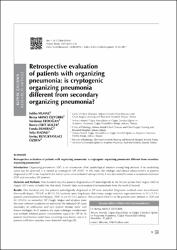Organize pnömonili olguların retrospektif değerlendirilmesi: Kriptojenik organize pnömoni sekonder organize pnömoniden farklı mıdır?

View/
Access
info:eu-repo/semantics/openAccessDate
2017Author
Yılmaz, SalihaÖzyürek Akıncı, Berna
Erdoğan, Yurdanur
Cirit Koçer, Burcu
Demirağ, Funda
Dadalı, Yeliz
Özden Büyükyaylacı, Sertaç
Metadata
Show full item recordAbstract
Giriş: Organize pnömoni (OP) akciğer hastalıkları içerisinde nadir görülen klinik opatolojik bir durumdur. Gerçek insidansı ve prevalansı bilinmemektedir. Altta yatan hastalık ya da neden belli değilse kriptojenik organize pnömoni (KOP) olarak adlandırılır. Bu çalışmamızda son 10 yılda hastanemizde tanı alan organize pnömoni olgularının retrospektif olarak, etyolojik ve klinik özelliklerinin değerlendirilmesi ve kriptojenik ve sekonder OP hastalarının birbiri ile karşılaştırılması amaçlanmıştır.Materyal ve Metod: Bu çalışmaya Ağustos 2003-Ağustos 2013 tarihleri arasında patolojik doku tanısı OP gelen 165 hasta dahil edildi. Hasta bilgileri retrospektif olarak hastane dosyalarından incelendi.Bulgular: Çalışmaya patolojik olarak OP tanısı konulmuş 165 hasta dahil edildi. Hastaların 89 (%53.9)'una transtorasik ince iğne aspirasyon biyopsisi (TTİAB), 52 (%31.5)'sine cerrahi yöntemle (lobektomi, wedge rezeksiyon, segmentektomi), 24 (%14.5)' üne transbronşiyal biyopsi (TBB) ile tanı konulmuştu. 100 (%60.6) hastanın KOP, 65 (%39.4) hastanın da sekonder OP olduğu belirlendi. En yaygın görülen semptomlar; öksürük, halsizlik, dispne idi. Elli beş (%44.7) hastada restriktif, 26 (%21.2) hastada obstrüktif solunum fonksiyon bozukluğuna rastlandı. Çalışmamızda sekonder organize pnömoniye sebep olan bilinen etyolojik ajanlara ek olarak antrokozise ve kist hidatiğe bağlı olarak gelişen organize pnömoni olguları saptadık. Altmış dokuz hastada OP'un tipik radyolojik görünümü olan yamalı vasıfta bilateral multipl opasiteler, 76 hastada fokal lezyonlar (solid kitle, kaviter kitle), 6 hastada da infiltratif opasiteler izlendi.Sonuç: OP'un kriptojenik ve sekonder formlarında OP'a ilişkin klinik, radyolojik ve laboratuvar özellikler açısından fark yoktur. Ülkemizde sekonder OP tanısı konulan hastalarda, etyolojide kist hidatik ve antrokoziste akılda tutulmalıdır. Introduction: Organizing pneumonia (OP) is an uncommon clinic opathological situation among lung diseases. If no underlying cause can be detected, it is named as cryptogenic OP (COP). In this study, the etiologic and clinical characteristics of patients diagnosed as OP in our hospital in the last ten years were evaluated retrospectively. It was also aimed to make a comparison between COP and secondary OP patients. Materials and Methods: One hundred sixty-five patients diagnosed as OP pathologically in the 10 year period from August 2003 to August 2013 were included into that study. Patients' data were evaluated retrospectively from the medical records. Results: One hundred sixty five patients pathologically diagnosed as OP were included. Diagnostic methods were trans-thoracic fine-needle biopsy (TTFNB) in 89 (53.9%) patients, open lung biopsy (lobectomy, wedge resection, segmentectomy) in 52 (31.5%) patients and transbronchial biyopsy (TBB) in 24 (14.5%) patients. One hundred (60.6%) of the patients were defined as COP and 65 (39.4%) as secondary OP. Cough, fatigue and dyspnea were the most common symptoms on admission. We detected OP cases secondary to anthracosis and cyst hydatic besides other well known etiologies. In 61 patients, the main radiologic manifestation was multiple bilateral patchy consolidation typical for OP. In 76 patients focal lesions (solid mass, cavitating mass lesion) and in 6 patients infiltrative opacities were detected radiologically. Conclusion: There is no difference between properties of OP from clinical, laboratory and radiologic finding sin the criptogenic and seconder form of OP. Although it is not asserted, cyst hidatic and anthracosis could be kept in mind for the list of underlying ethiologies for secondary OP.

















